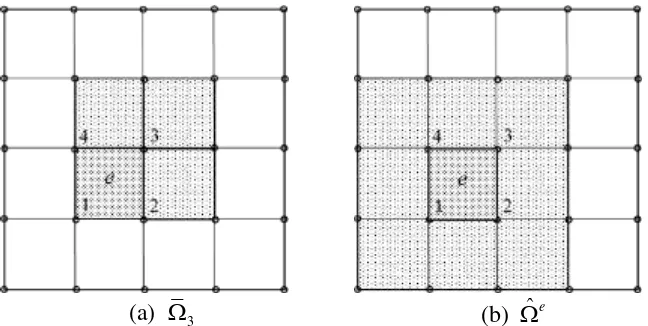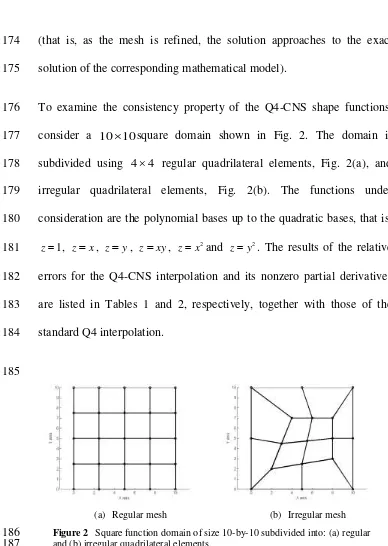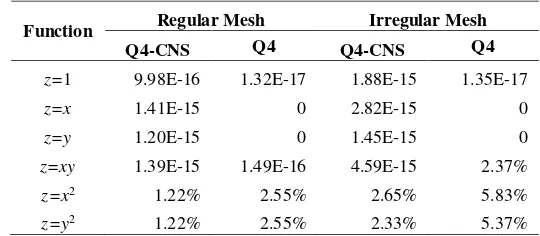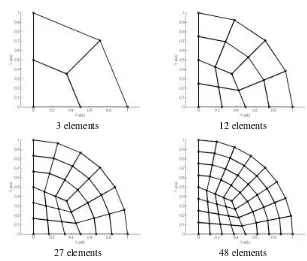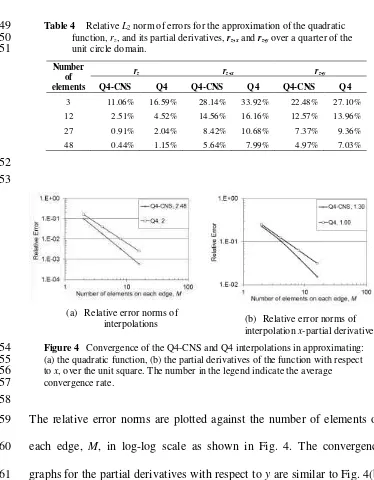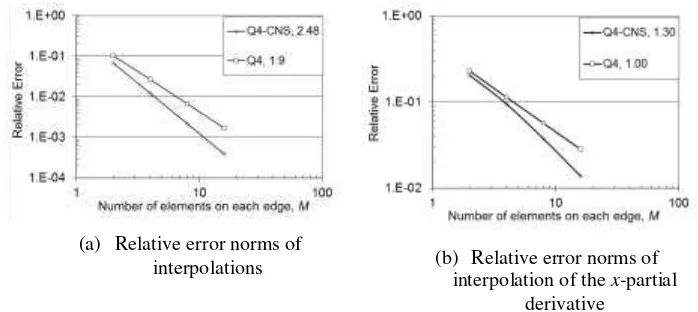Received ________, Revised _________, Accepted for publication __________
On the Accuracy and Convergence of the Hybrid
FE-1meshfree Q4-CNS Element in Surface Fitting Problems
2Foek Tjong Wong1, Richo Michael Soetanto2 & Januar Budiman3
3
Master Program of Civil Engineering, Petra Christian University, Surabaya, Indonesia 4
Email: 1 [email protected], 2 [email protected], 3 [email protected] 5
6 7
Abstract. In the last decade, several hybrid methods combining the finite 8
element and meshfree methods have been proposed for solving elasticity 9
problems. Among these methods, a novel quadrilateral four-node element with 10
continuous nodal stress (Q4-CNS) is of our interest. In this method, the shape 11
functions are constructed using the combination of the ‘non-conforming’ shape 12
functions for the Kirchhoff’s plate rectangular element and the shape functions 13
obtained using an orthonormalized and constrained least-squares method. The 14
key advantage of the Q4-CNS element is that it provides the continuity of the 15
gradients at the element nodes so that the global gradient fields are smooth and 16
accuracy and convergence. Furthermore, the consistency property of the Q4-20
CNS interpolation was also examined. The results show that the Q4-CNS 21
interpolation possess a bi-linier order of consistency even in a distorted mesh. 22
The Q4-CNS gives highly accurate surface fittings and possess excellent 23
convergence characteristics. The accuracy and convergence rates are better than 24
those of the standard Q4 element. 25
Keywords: continuous nodal stress; finite element; meshfree; Q4-CNS; quadrilateral
26
four-node element; surface fitting.
27
1 Introduction 28
The finite element method (FEM) is now a widely-used, well-establish 29
numerical method for solving mathematical models of practical problems 30
in engineering and science. In practice, FEM users often prefer to use 31
simple, low order triangular or quadrilateral elements in 2D problems and 32
automatically generated with ease for meshing complicated geometries. 34
Nevertheless, the standard low order elements produce discontinuous 35
gradient fields on the element boundaries and their accuracy is sensitive 36
to the quality of the mesh. 37
To overcome the FEM shortcomings, since the early 1990’s up to present 38
a vast amount of meshfree (or meshless) methods [1], [2], which do not 39
require a mesh in discretizing the problem domain, have been proposed. 40
A recent review on meshfree methods presented by Liu [3]. While these 41
newer methods are able to eliminate the FEM shortcomings, they also 42
have their own, such as: (i) the computational cost is much more 43
expensive than the FEM, and (ii) the computer implementation is quite 44
different from that of the standard FEM. 45
To synergize the strengths of the finite element and meshfree methods 46
while avoiding their weaknesses, in the last decade several hybrid 47
methods combining the two classes of methods based on the concept of 48
partition-of-unity have been developed [4]-[8]. Among several hybrid 49
methods available in literature, the authors are interested in the four-node 50
quadrilateral element with continuous nodal stress (Q4-CNS) proposed 51
method possessing the property of continuous nodal stress. The Q4-CNS 53
can be regarded as an improved version of the FE-LSPIM Q4 [4], [5]. In 54
this novel method, the nonconforming shape functions for the 55
Kirchhoff’s plate rectangular element are combined with the shape 56
functions obtained using an orthonormalized and constrained least-57
squares method. The advantages of the Q4-CNS are [6], [9], [10]: (1) the 58
shape functions are C1 continuous at nodes so that it naturally provides a 59
globally smooth gradient fields. (2) The Q4-CNS can give higher 60
accuracy and faster convergence rate than the standard quadrilateral 61
element (Q4). (3) The Q4-CNS is more tolerant to mesh distortion. 62
The Q4-CNS has been developed and applied for the free and forced 63
vibration analyses of 2D solids [9] and for 2D crack propagation analysis 64
[10]. Recently the Q4-CNS has been further developed to its 3D 65
counterpart, that is, the hybrid FE-meshfree eight-node hexahedral 66
element with continuous nodal stress (Hexa8-CNS) [11]. However, 67
examination of the Q4-CNS interpolation in fitting surfaces defined by 68
functions of two variables has not been carried out. Thus, it is the 69
purpose of this paper to present a numerical study on the on the accuracy 70
surface fitting problems. Furthermore, the consistency (or completeness) 72
property of the Q4-CNS shape functions is numerically examined in this 73
study. 74
2 The Q4-CNS Interpolation 75
As in the standard finite element procedure, a 2D problem domain, , is 76
firstly divided into four-node quadrilateral elements to construct the Q4-77
CNS shape functions. Consider a typical element e with the local node 78
labels 1, 2, 3 and 4. The unknown function u on the interior and boundary 79
of the element is approximated by 80
approximations, respectively, associated with node i, i=1,…,4. Note that
83
in the classical isoparametric four-node quadrilateral element (Q4), the 84
where ξ and η are the natural coordinates of the classical Q4 with the 91
values in the range of –1 to 1. The weight functions satisfy the partition 92
of unity property, that is, 4
1wi( , ) 1
. The nodal approximations93
ui(x,y) are constructed using the orthonormalized and constrained least-94
squares method (CO-LS) as presented by Tang et al. [6] and Yang et al. 95
[9], [10]. Here the CO-LS is briefly reviewed. 96
To construct the CO-LS approximation, nodal support domains of node i, 97
i
, i=1,…,4 of a typical quadrilateral element eare firstly defined 98
using the neighboring nodes of node i. For example, the nodal support 99
domain of node 3 of element e is shown in Fig. 1(a). The element support 100
domain ˆeis then defined as the union of the four nodal support 101
domains, that is, ˆe 41 i, as shown in Fig. 1(b). 102
Consider a nodal support domain of node i, i with the total number of 103
supporting nodes n. Let the labels for the nodes be j, j=1,…, n. Using the 104
least-squares method, the nodal approximation ui(x,y) is given as 105
T 1
( , ) ( , )
i
u x y p x y A Ba (3)
106
where p(x, y) is a vector of polynomial basis functions, viz. 107
T 2 2
( , )x y 1 x y x xy y
p (1m) (4)
(a) 3 (b) ˆe
Figure 1 Definitions of: (a) the nodal support domain of node 3 of element e
109
and (b) the element support domain of element e. 110
Here m is the number of monomial bases in p. Following the original 111
work [6], in this study the ‘serendipity’ basis function 112
T 2 2 2 2
( , )x y 1 x y x xy y x y xy
p is used if n8 and the
bi-113
linear basis function pT( , )x y
1 x y xy
is used if n8. Matrices A 114and B are the moment matrix and the basis matrix, respectively, given as 115
T 1 ( , ) ( , ) n
j j j j j x y x y
A p p (m m ) (5)
116
( , )x y1 1 ( ,x y2 2) ( ,x yn n)
B p p p (m n ) (6)
117
Vector a
a1 a2 an
Tis the vector of nodal parameters. Note that 118in general vector a is not a vector of nodal values because the 119
approximation ui(x,y) does not necessarily pass through the nodal values. 120
f x y g x y( , ), ( , )
nj1f x y g x y( ,j j) ( ,j j) (7)122
and using the Gram-Schmidt orthonormalization algorithm [6], the basis 123
vector p can be transformed into an orthonormal basis function vector r 124
so that the moment matrix A becomes the identity matrix. Subsequently, 125
the nodal approximation is constrained using the Lagrange multiplier 126
method so that the nodal parameter ui(x,y) at node i is equal to the nodal 127
value ui. Going through the abovementioned process, the nodal 128
Consider now the element support domain of element e, ˆe, with the
(1), the approximate function can be expressed as 141
the element support domain. In this equation, if node I is not in the nodal 144
support domain of node i, then i( , )
I x y
is defined to be zero. It is obvious 145
that the shape function is the product of the nonconforming rectangular 146
examined. To measure the approximation errors, the following relative L2
154
2
using Gaussian quadrature rule. The number of quadrature sampling 162
points is taken to be 5 5 . For the purpose of comparison, the accuracy 163
and convergence of the standard Q4 interpolation and its partial 164
derivatives are also presented. 165
3.1 Shape function consistency property 166
In order to be applicable as the basis functions in the Rayleigh-Ritz based 167
numerical method, a set of shape functions is required to be able to 168
represent exactly all polynomial terms of order up to m in the Cartesian 169
coordinates [13], where m is the variational index (that is, the highest 170
order of the spatial derivatives that appears in the problem functional). A 171
set of shape functions that satisfies this condition is called m-consistent 172
(that is, as the mesh is refined, the solution approaches to the exact 174
solution of the corresponding mathematical model). 175
To examine the consistency property of the Q4-CNS shape functions, 176
consider a 10 10 square domain shown in Fig. 2. The domain is 177
subdivided using 4 4 regular quadrilateral elements, Fig. 2(a), and 178
irregular quadrilateral elements, Fig. 2(b). The functions under 179
consideration are the polynomial bases up to the quadratic bases, that is, 180
1
z , zx, z y, zxy, 2
zx and 2
z y . The results of the relative 181
errors for the Q4-CNS interpolation and its nonzero partial derivatives 182
are listed in Tables 1 and 2, respectively, together with those of the 183
standard Q4 interpolation. 184
185
(a) Regular mesh (b) Irregular mesh
Figure 2 Square function domain of size 10-by-10 subdivided into: (a) regular 186
and (b) irregular quadrilateral elements. 187
Table 1 Relative L2 norm of errors for the approximation of different 189
polynomial basis functions using the regular and irregular meshes. 190
Function Regular Mesh Irregular Mesh
Q4-CNS Q4 Q4-CNS Q4
Table 2 Relative L2 norm of errors for the approximation of nonzero 192
polynomial basis function derivatives using the regular and irregular 193
meshes. 194
(a) Basis function derivatives with respect to x
195
Function Derivative to
x
Regular Mesh Irregular Mesh
Q4-CNS Q4 Q4-CNS Q4
z,x=1 9.11E-15 2.25E-16 2.15E-14 2.82E-16 z,x=y 9.36E-15 2.55E-16 3.06E-14 11.32% z,x=2x 6.70% 12.50% 10.94% 16.58%
(b) Basis function derivatives with respect to y
196
Function Derivative to
y
Regular Mesh Irregular Mesh
Q4-CNS Q4 Q4-CNS Q4
irregular meshes. In other words, the Q4-CNS interpolation is consistent 200
up to the same basis for the regular mesh, but it is only purely linear 202
consistent for the irregular mesh. This finding may partly explain the 203
reason the Q4-CNS has higher tolerance to mesh distortion [6]. For the x2
204
and y2 bases, both the Q4-CNS and Q4 interpolations are not able to 205
produce the exact solutions, as expected. For these bases, the Q4-CNS 206
interpolation is consistently more accurate than the standard Q4. 207
The tables clearly reveals that the Q4-CNS interpolation is not consistent 208
up to all of the quadratic bases. As a consequence, the Q4-CNS is not 209
applicable to variational problems possessing variational index m=2, 210
including the Love-Kirchhoff plate bending and shell models. This is in 211
contradiction to the statement made in the original paper [6], which 212
mentioned that the Q4-CNS “is potentially useful for the problems of 213
bending plate and shell models”. If the Reissner-Mindlin theory is 214
adopted, however, the Q4-CNS is of course applicable. 215
3.2 Accuracy and Convergence 216
3.2.1 Quadratic function 217
The accuracy and convergence of the Q4-CNS interpolation in fitting 218
functions in 2D domain are firstly examined using quadratic function 219
2 2
1
z x y (16)
221
with two different domains, viz. 222
S ( , ) 0x y x 1, 0 y 1
(17)
223
2 2
C ( , )x y x y 1,x 0,y 0
(18)
224
The first domain, Eqn. (17), is the unit square while the second one, Eqn. 225
(18), is a quarter of the unit circle, both of which are located in the first 226
quadrant of the Cartesian coordinate system. The unit square is 227
subdivided using regular meshes of 2 2 , 4 4 , 8 8 , and 16 16 square 228
elements. The quarter of the unit circle is subdivided into 3, 12, 27, and 229
48 quadrilateral elements as shown in Fig. 3 (taken from an example in 230
Katili [15]). 231
The relative error norms of the Q4-CNS and Q4 interpolations in 232
approximating the quadratic function, Eqn. (16), and its partial 233
derivatives, are presented in Table 3 for the square domain and in Table 4 234
for the quarter circle domain. The tables show that the Q4-CNS 235
interpolation converges very well to the quadratic function z both for the 236
regular mesh in the unit square domain and for the relatively irregular 237
mesh in the quarter of the unit circle domain. The tables also confirm that 238
interpolation. The finer the mesh the more accurate the Q4-CNS 240
interpolation compared to the Q4. 241
242
3 elements 12 elements
27 elements 48 elements
Figure 3 A quarter of the unit circle subdivided into different number of 243
quadrilateral elements (Katili [15], p.1899). 244
245
Table 3 Relative L2 norm of errors for the approximation of the quadratic 246
function, rz, and its partial derivatives, rz,x and rz,y over the unit square
247
domain. 248
M rz rz,x rz,y
Q4-CNS Q4 Q4-CNS Q4 Q4-CNS Q4
2 10.18% 16.26% 22.77% 25.00% 26.29% 28.87%
4 1.83% 4.07% 10.62% 12.50% 12.26% 14.43%
8 0.33% 1.02% 4.13% 6.25% 4.77% 7.22%
16 0.06% 0.25% 1.52% 3.13% 1.76% 3.61%
Table 4 Relative L2 norm of errors for the approximation of the quadratic 249
function, rz, and its partial derivatives, rz,x and rz,y over a quarter of the
250
unit circle domain. 251
Number of elements
rz rz,x rz,y
Q4-CNS Q4 Q4-CNS Q4 Q4-CNS Q4
3 11.06% 16.59% 28.14% 33.92% 22.48% 27.10% 12 2.51% 4.52% 14.56% 16.16% 12.57% 13.96%
27 0.91% 2.04% 8.42% 10.68% 7.37% 9.36%
48 0.44% 1.15% 5.64% 7.99% 4.97% 7.03%
252
253
(a) Relative error norms of
interpolations (b) Relative error norms of interpolation x-partial derivative Figure 4 Convergence of the Q4-CNS and Q4 interpolations in approximating: 254
(a) the quadratic function, (b) the partial derivatives of the function with respect 255
to x, over the unit square. The number in the legend indicate the average 256
convergence rate. 257
258
The relative error norms are plotted against the number of elements on 259
each edge, M, in log-log scale as shown in Fig. 4. The convergence 260
graphs for the partial derivatives with respect to y are similar to Fig. 4(b) 261
and have the same convergence rates. The graphs show that the average 262
convergence rate of the Q4-CNS interpolation is about 25% faster than 263
the Q4 interpolation, 2, and its partial derivatives, 1, are exactly the same 265
as predicted by the interpolation theory [16]. 266
3.2.2 Cosine function 267
The second function chosen to examine the accuracy and convergence of 268
the Q4-CNS interpolation is 269
cos( ) cos( )
2 2
z x y (19)
270
defined over the square unit domain, Eqn. (17). The meshes used are the 271
same as those in the previous example. 272
The convergence graphs of the relative error norms of the Q4-CNS and 273
Q4 interpolations and their partial derivatives with respect to x are shown 274
in Fig. 5. The graphs confirm the superiority of the Q4-CNS interpolation 275
over the Q4 interpolation both in terms of the accuracy and convergence 276
rate. 277
4 Conclusions 278
The consistency property, accuracy and convergence of the Q4-CNS 279
interpolation in surface fitting problems have been numerically studied. 280
The results show that the Q4-CNS interpolation is consistent up to the 281
bilinear basis both for the regular and irregular meshes. It is more 282
sufficiently fine mesh, the error norm of the Q4-CNS interpolation is 284
around 3 to 4 times smaller than that of the Q4, and the error norm of its 285
derivatives is around 1.5 to 2 times smaller than that of the Q4. The Q4-286
CNS interpolation converge very well to the fitted function. Its 287
convergence rate is approximately 25% faster than that of the Q4. The 288
demerits of the present method is that the computational cost to construct 289
the shape function is much higher than the Q4 shape function. 290
291
(a) Relative error norms of
interpolations (b) Relative error norms of interpolation of the x-partial
derivative Figure 5 Convergence of the Q4-CNS and Q4 interpolations in approximating: 292
(a) the bi-cosine function, (b) the partial derivatives of the function with respect 293
to x, over the unit square. The number in the legend indicate the average 294
convergence rate. 295
296
297
Acknowledgement 299
We gratefully acknowledge that this research is partially supported by the 300
research grant of the Institute of Research and Community Service, Petra 301
Christian University, Surabaya. 302
5 References 303
[1] Liu, G.R., Mesh Free Methods: Moving Beyond the Finite Element
304
Method, 1st ed., Boca Raton: CRC Press, 1-5, 2003. 305
[2] Gu, Y.T., Meshfree Methods and Their Comparisons, International 306
Journal of Computational Methods, 2(4), pp. 477–515, 2005. 307
[3] Liu, G.R., An Overview on Meshfree Methods: For Computational
308
Solid Mechanics, International Journal of Computational Methods, 309
13(5), pp. 1630001-1–1630001-42, 2016. 310
[4] Rajendran, S. & Zhang, B.R., A ‘FE-meshfree’ Q4 Element Based
311
on Partition of Unity, Computer Methods in Applied Mechanics 312
and Engineering, 197(1–4), pp. 128–147, 2007. 313
[5] Zhang, B.R. & Rajendran, S., ‘FE-meshfree’ Q4 Element for
Free-314
vibration Analysis, Computer Methods in Applied Mechanics and 315
[6] Tang, X.H., Zheng, C., Wu, S.C., & Zhang, J.H., A Novel
Four-317
node Quadrilateral Element with Continuous Nodal Stress, Applied 318
Mathematics and Mechanics, 30(12), pp. 1519–1532, 2009. 319
[7] Yang, Y., Tang, X.H., & Zheng, H., A Three-node Triangular
320
Element with Continuous Nodal Stress, Computers & Structures, 321
141, pp. 46–58, 2014. 322
[8] Yang, Y., Bi, R., & Zheng, H., A Hybrid ‘FE-meshless’ Q4 with
323
Continuous Nodal Stress using Radial-polynomial Basis Functions, 324
Engineering Analysis with Boundary Elements, 53, pp. 73–85, 325
2015. 326
[9] Yang, Y., Chen, L., Xu, D., & Zheng, H., Free and Forced
327
Vibration Analyses using the Four-node Quadrilateral Element
328
with Continuous Nodal Stress, Engineering Analysis with 329
Boundary Elements, 70, pp. 1–11, 2016. 330
[10] Yang, Y., Sun, G., Zheng, H., & Fu, X., A Four-node
331
Quadrilateral Element Fitted to Numerical Manifold Method with
332
Continuous Nodal Stress for Crack Analysis, Computers & 333
Structures, 177, pp. 69–82, 2016. 334
[11] Yang, Y., Chen, L., Tang, X.H., Zheng, H., & Liu, Q.S., A
335
Partition-of-unity Based ‘FE-meshfree’ Hexahedral Element with
Continuous Nodal Stress, Computers & Structures, 178, pp. 17–28, 337
2017. 338
[12] Zienkiewicz, O.C. & Taylor, R.L., The Finite Element Method,
339
Volume 2: Solid Mechanics, 5th ed., Butterworth-Heinemann, 126, 340
2000. 341
[13] Felippa, C.A., Introduction To Finite Element Methods (ASEN
342
5007), Fall 2016 , University of Colorado at Boulder, 343
http://www.colorado.edu/engineering/cas/courses.d/IFEM.d/, (14-344
Oct-2016). 345
[14] Wong, F. T. & Kanok-Nukulchai, W., Kriging-based Finite
346
Element Method : Element-by-Element Kriging Interpolation, Civil 347
Engineering Dimension, 11(1), pp. 15–22, 2009. 348
[15] Katili, I., A New Discrete Kirchhoff-Mindlin Element based on
349
Mindlin-Reissner Plate Theory and Assumed Shear Strain Fields-
350
Part II: an Extended DKQ Element for Thick-Plate Bending
351
Analysis, International Journal for Numerical Methods in 352
Engineering, 36(11), pp. 1885–1908, 1993. 353
[16] Bathe, K.J., Finite Element Procedures, Prentice-Hall, 244-250, 354
